Business Proposal: Enhancing Performance Through Feedback at Opal-Mart
VerifiedAdded on 2020/03/28
|5
|1371
|237
Report
AI Summary
This business proposal addresses the need for improved staff performance at Opal-Mart through the implementation of a robust feedback mechanism. The rationale emphasizes the importance of two-way communication between management and staff, highlighting the current barriers due to ineffective feedback models. The scope of the training encompasses all staff levels, including managers and senior executives, to identify problem areas and enhance performance. The training plan focuses on strengthening employee engagement through an open communication model, including surveys and suggestion boxes. The proposal outlines the benefits, such as reduced conflicts and enhanced employee engagement, and emphasizes the positive impact on the overall business environment. The report includes a comprehensive overview of the training's contents, timeframe, and delivery mode, and references relevant academic sources to support the proposed strategies.
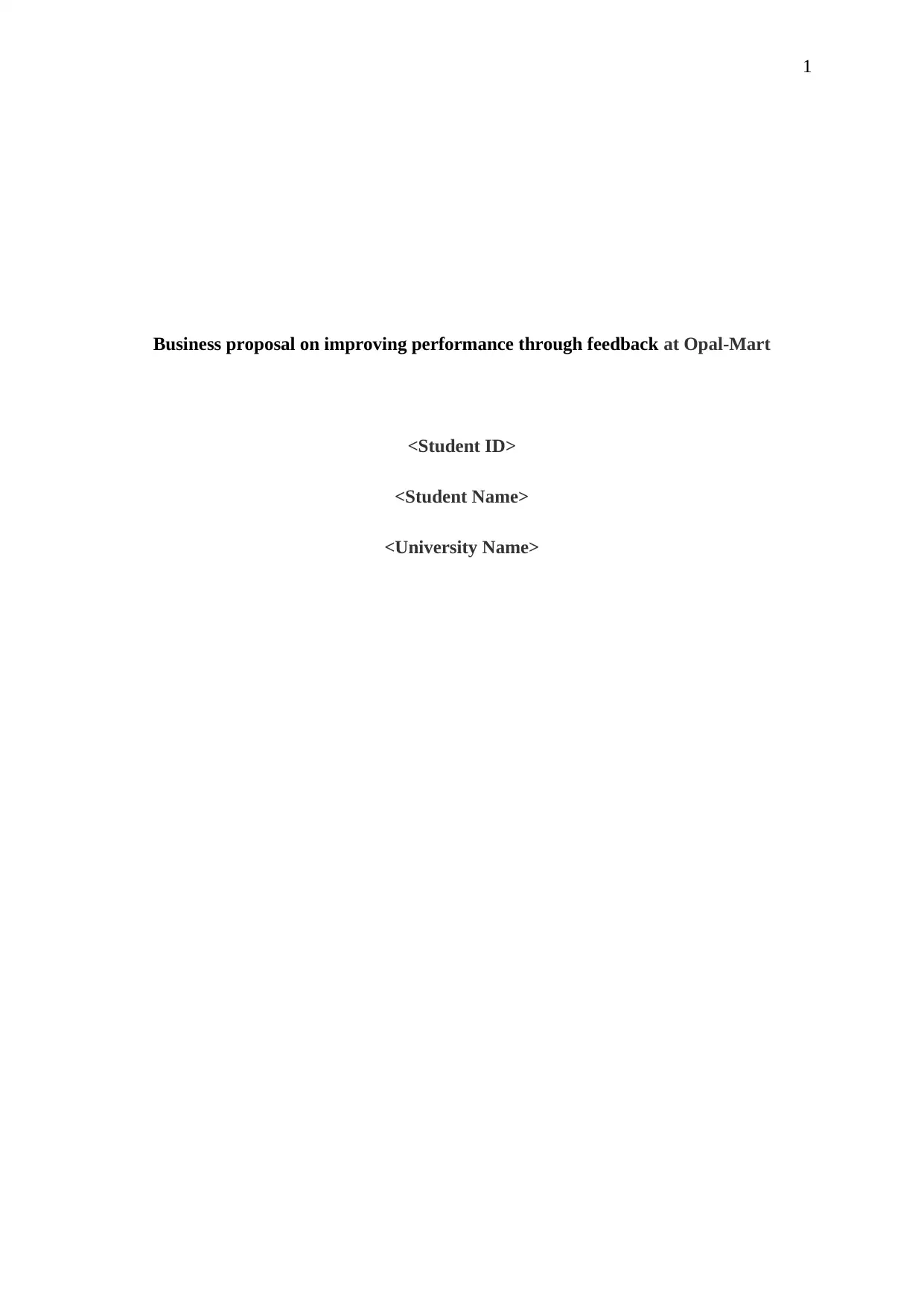
1
Business proposal on improving performance through feedback at Opal-Mart
<Student ID>
<Student Name>
<University Name>
Business proposal on improving performance through feedback at Opal-Mart
<Student ID>
<Student Name>
<University Name>
Paraphrase This Document
Need a fresh take? Get an instant paraphrase of this document with our AI Paraphraser
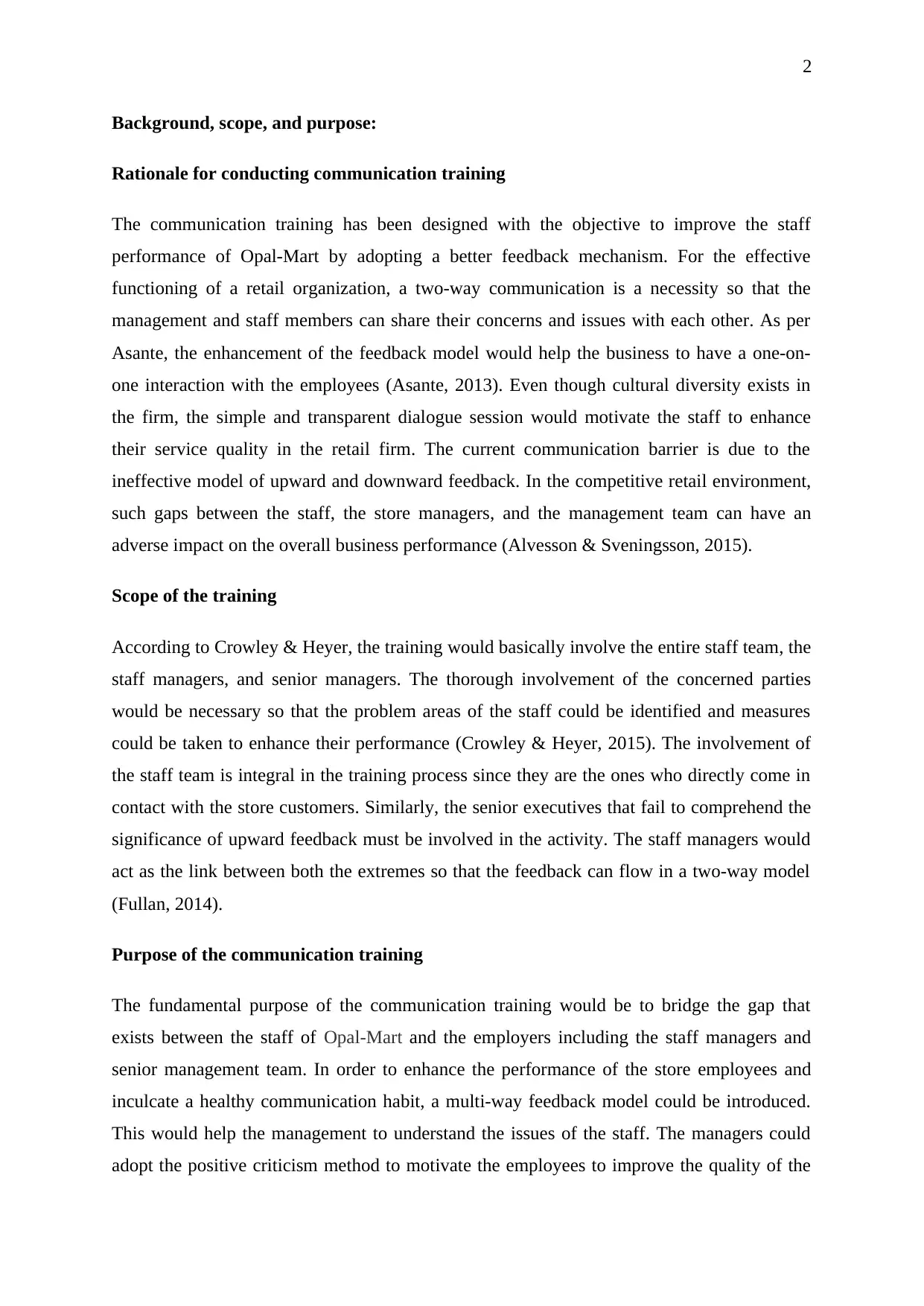
2
Background, scope, and purpose:
Rationale for conducting communication training
The communication training has been designed with the objective to improve the staff
performance of Opal-Mart by adopting a better feedback mechanism. For the effective
functioning of a retail organization, a two-way communication is a necessity so that the
management and staff members can share their concerns and issues with each other. As per
Asante, the enhancement of the feedback model would help the business to have a one-on-
one interaction with the employees (Asante, 2013). Even though cultural diversity exists in
the firm, the simple and transparent dialogue session would motivate the staff to enhance
their service quality in the retail firm. The current communication barrier is due to the
ineffective model of upward and downward feedback. In the competitive retail environment,
such gaps between the staff, the store managers, and the management team can have an
adverse impact on the overall business performance (Alvesson & Sveningsson, 2015).
Scope of the training
According to Crowley & Heyer, the training would basically involve the entire staff team, the
staff managers, and senior managers. The thorough involvement of the concerned parties
would be necessary so that the problem areas of the staff could be identified and measures
could be taken to enhance their performance (Crowley & Heyer, 2015). The involvement of
the staff team is integral in the training process since they are the ones who directly come in
contact with the store customers. Similarly, the senior executives that fail to comprehend the
significance of upward feedback must be involved in the activity. The staff managers would
act as the link between both the extremes so that the feedback can flow in a two-way model
(Fullan, 2014).
Purpose of the communication training
The fundamental purpose of the communication training would be to bridge the gap that
exists between the staff of Opal-Mart and the employers including the staff managers and
senior management team. In order to enhance the performance of the store employees and
inculcate a healthy communication habit, a multi-way feedback model could be introduced.
This would help the management to understand the issues of the staff. The managers could
adopt the positive criticism method to motivate the employees to improve the quality of the
Background, scope, and purpose:
Rationale for conducting communication training
The communication training has been designed with the objective to improve the staff
performance of Opal-Mart by adopting a better feedback mechanism. For the effective
functioning of a retail organization, a two-way communication is a necessity so that the
management and staff members can share their concerns and issues with each other. As per
Asante, the enhancement of the feedback model would help the business to have a one-on-
one interaction with the employees (Asante, 2013). Even though cultural diversity exists in
the firm, the simple and transparent dialogue session would motivate the staff to enhance
their service quality in the retail firm. The current communication barrier is due to the
ineffective model of upward and downward feedback. In the competitive retail environment,
such gaps between the staff, the store managers, and the management team can have an
adverse impact on the overall business performance (Alvesson & Sveningsson, 2015).
Scope of the training
According to Crowley & Heyer, the training would basically involve the entire staff team, the
staff managers, and senior managers. The thorough involvement of the concerned parties
would be necessary so that the problem areas of the staff could be identified and measures
could be taken to enhance their performance (Crowley & Heyer, 2015). The involvement of
the staff team is integral in the training process since they are the ones who directly come in
contact with the store customers. Similarly, the senior executives that fail to comprehend the
significance of upward feedback must be involved in the activity. The staff managers would
act as the link between both the extremes so that the feedback can flow in a two-way model
(Fullan, 2014).
Purpose of the communication training
The fundamental purpose of the communication training would be to bridge the gap that
exists between the staff of Opal-Mart and the employers including the staff managers and
senior management team. In order to enhance the performance of the store employees and
inculcate a healthy communication habit, a multi-way feedback model could be introduced.
This would help the management to understand the issues of the staff. The managers could
adopt the positive criticism method to motivate the employees to improve the quality of the
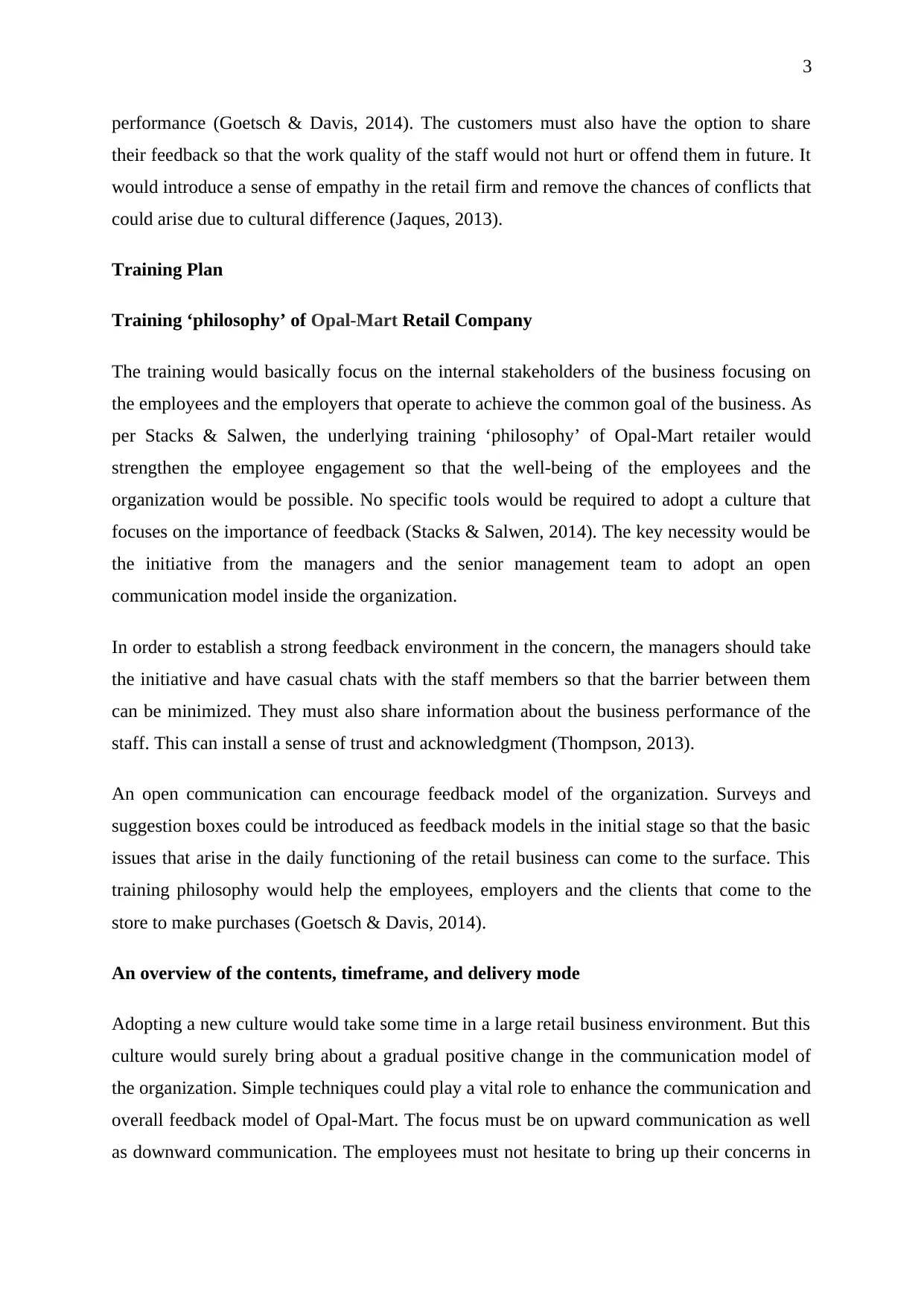
3
performance (Goetsch & Davis, 2014). The customers must also have the option to share
their feedback so that the work quality of the staff would not hurt or offend them in future. It
would introduce a sense of empathy in the retail firm and remove the chances of conflicts that
could arise due to cultural difference (Jaques, 2013).
Training Plan
Training ‘philosophy’ of Opal-Mart Retail Company
The training would basically focus on the internal stakeholders of the business focusing on
the employees and the employers that operate to achieve the common goal of the business. As
per Stacks & Salwen, the underlying training ‘philosophy’ of Opal-Mart retailer would
strengthen the employee engagement so that the well-being of the employees and the
organization would be possible. No specific tools would be required to adopt a culture that
focuses on the importance of feedback (Stacks & Salwen, 2014). The key necessity would be
the initiative from the managers and the senior management team to adopt an open
communication model inside the organization.
In order to establish a strong feedback environment in the concern, the managers should take
the initiative and have casual chats with the staff members so that the barrier between them
can be minimized. They must also share information about the business performance of the
staff. This can install a sense of trust and acknowledgment (Thompson, 2013).
An open communication can encourage feedback model of the organization. Surveys and
suggestion boxes could be introduced as feedback models in the initial stage so that the basic
issues that arise in the daily functioning of the retail business can come to the surface. This
training philosophy would help the employees, employers and the clients that come to the
store to make purchases (Goetsch & Davis, 2014).
An overview of the contents, timeframe, and delivery mode
Adopting a new culture would take some time in a large retail business environment. But this
culture would surely bring about a gradual positive change in the communication model of
the organization. Simple techniques could play a vital role to enhance the communication and
overall feedback model of Opal-Mart. The focus must be on upward communication as well
as downward communication. The employees must not hesitate to bring up their concerns in
performance (Goetsch & Davis, 2014). The customers must also have the option to share
their feedback so that the work quality of the staff would not hurt or offend them in future. It
would introduce a sense of empathy in the retail firm and remove the chances of conflicts that
could arise due to cultural difference (Jaques, 2013).
Training Plan
Training ‘philosophy’ of Opal-Mart Retail Company
The training would basically focus on the internal stakeholders of the business focusing on
the employees and the employers that operate to achieve the common goal of the business. As
per Stacks & Salwen, the underlying training ‘philosophy’ of Opal-Mart retailer would
strengthen the employee engagement so that the well-being of the employees and the
organization would be possible. No specific tools would be required to adopt a culture that
focuses on the importance of feedback (Stacks & Salwen, 2014). The key necessity would be
the initiative from the managers and the senior management team to adopt an open
communication model inside the organization.
In order to establish a strong feedback environment in the concern, the managers should take
the initiative and have casual chats with the staff members so that the barrier between them
can be minimized. They must also share information about the business performance of the
staff. This can install a sense of trust and acknowledgment (Thompson, 2013).
An open communication can encourage feedback model of the organization. Surveys and
suggestion boxes could be introduced as feedback models in the initial stage so that the basic
issues that arise in the daily functioning of the retail business can come to the surface. This
training philosophy would help the employees, employers and the clients that come to the
store to make purchases (Goetsch & Davis, 2014).
An overview of the contents, timeframe, and delivery mode
Adopting a new culture would take some time in a large retail business environment. But this
culture would surely bring about a gradual positive change in the communication model of
the organization. Simple techniques could play a vital role to enhance the communication and
overall feedback model of Opal-Mart. The focus must be on upward communication as well
as downward communication. The employees must not hesitate to bring up their concerns in
⊘ This is a preview!⊘
Do you want full access?
Subscribe today to unlock all pages.

Trusted by 1+ million students worldwide
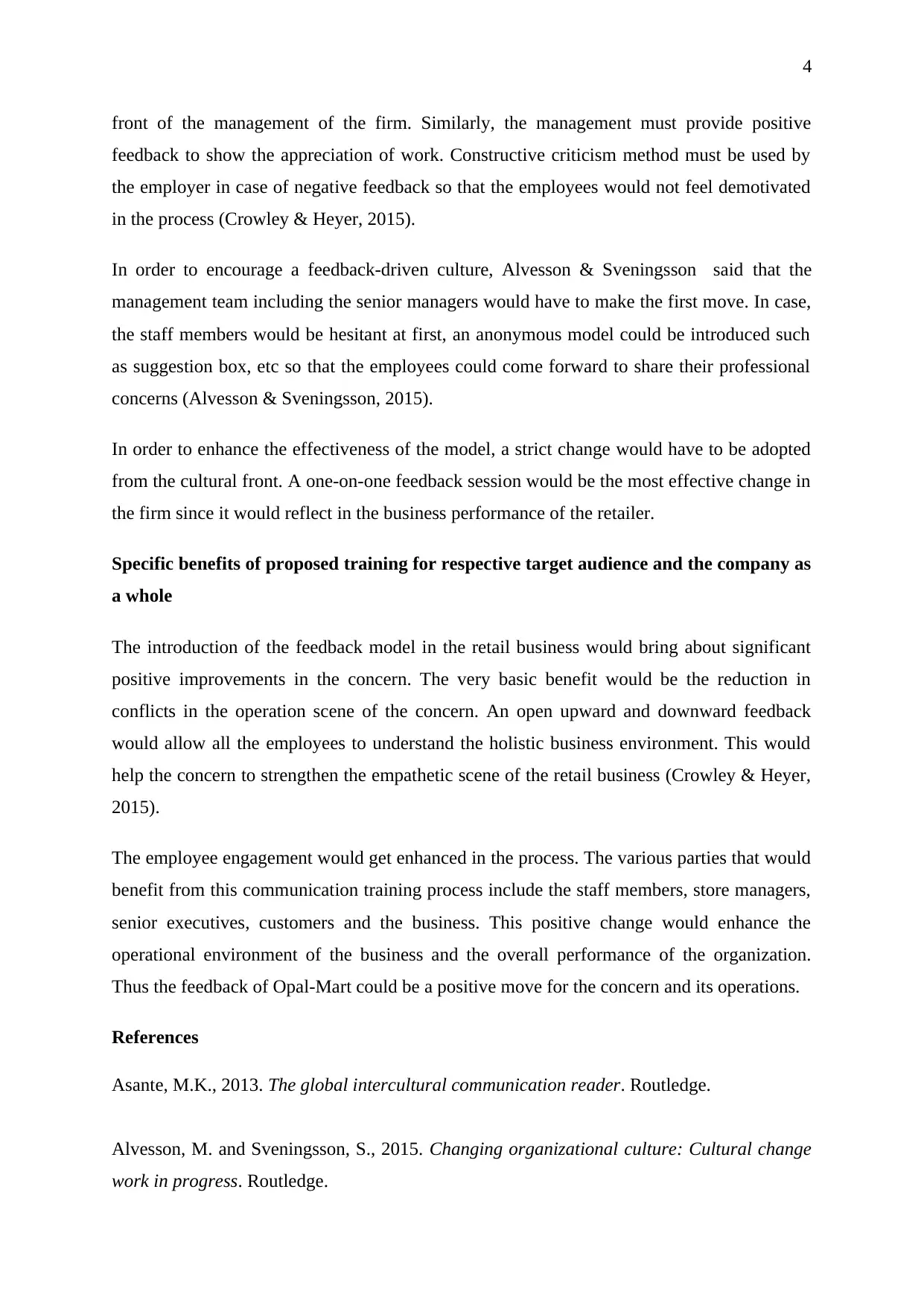
4
front of the management of the firm. Similarly, the management must provide positive
feedback to show the appreciation of work. Constructive criticism method must be used by
the employer in case of negative feedback so that the employees would not feel demotivated
in the process (Crowley & Heyer, 2015).
In order to encourage a feedback-driven culture, Alvesson & Sveningsson said that the
management team including the senior managers would have to make the first move. In case,
the staff members would be hesitant at first, an anonymous model could be introduced such
as suggestion box, etc so that the employees could come forward to share their professional
concerns (Alvesson & Sveningsson, 2015).
In order to enhance the effectiveness of the model, a strict change would have to be adopted
from the cultural front. A one-on-one feedback session would be the most effective change in
the firm since it would reflect in the business performance of the retailer.
Specific benefits of proposed training for respective target audience and the company as
a whole
The introduction of the feedback model in the retail business would bring about significant
positive improvements in the concern. The very basic benefit would be the reduction in
conflicts in the operation scene of the concern. An open upward and downward feedback
would allow all the employees to understand the holistic business environment. This would
help the concern to strengthen the empathetic scene of the retail business (Crowley & Heyer,
2015).
The employee engagement would get enhanced in the process. The various parties that would
benefit from this communication training process include the staff members, store managers,
senior executives, customers and the business. This positive change would enhance the
operational environment of the business and the overall performance of the organization.
Thus the feedback of Opal-Mart could be a positive move for the concern and its operations.
References
Asante, M.K., 2013. The global intercultural communication reader. Routledge.
Alvesson, M. and Sveningsson, S., 2015. Changing organizational culture: Cultural change
work in progress. Routledge.
front of the management of the firm. Similarly, the management must provide positive
feedback to show the appreciation of work. Constructive criticism method must be used by
the employer in case of negative feedback so that the employees would not feel demotivated
in the process (Crowley & Heyer, 2015).
In order to encourage a feedback-driven culture, Alvesson & Sveningsson said that the
management team including the senior managers would have to make the first move. In case,
the staff members would be hesitant at first, an anonymous model could be introduced such
as suggestion box, etc so that the employees could come forward to share their professional
concerns (Alvesson & Sveningsson, 2015).
In order to enhance the effectiveness of the model, a strict change would have to be adopted
from the cultural front. A one-on-one feedback session would be the most effective change in
the firm since it would reflect in the business performance of the retailer.
Specific benefits of proposed training for respective target audience and the company as
a whole
The introduction of the feedback model in the retail business would bring about significant
positive improvements in the concern. The very basic benefit would be the reduction in
conflicts in the operation scene of the concern. An open upward and downward feedback
would allow all the employees to understand the holistic business environment. This would
help the concern to strengthen the empathetic scene of the retail business (Crowley & Heyer,
2015).
The employee engagement would get enhanced in the process. The various parties that would
benefit from this communication training process include the staff members, store managers,
senior executives, customers and the business. This positive change would enhance the
operational environment of the business and the overall performance of the organization.
Thus the feedback of Opal-Mart could be a positive move for the concern and its operations.
References
Asante, M.K., 2013. The global intercultural communication reader. Routledge.
Alvesson, M. and Sveningsson, S., 2015. Changing organizational culture: Cultural change
work in progress. Routledge.
Paraphrase This Document
Need a fresh take? Get an instant paraphrase of this document with our AI Paraphraser
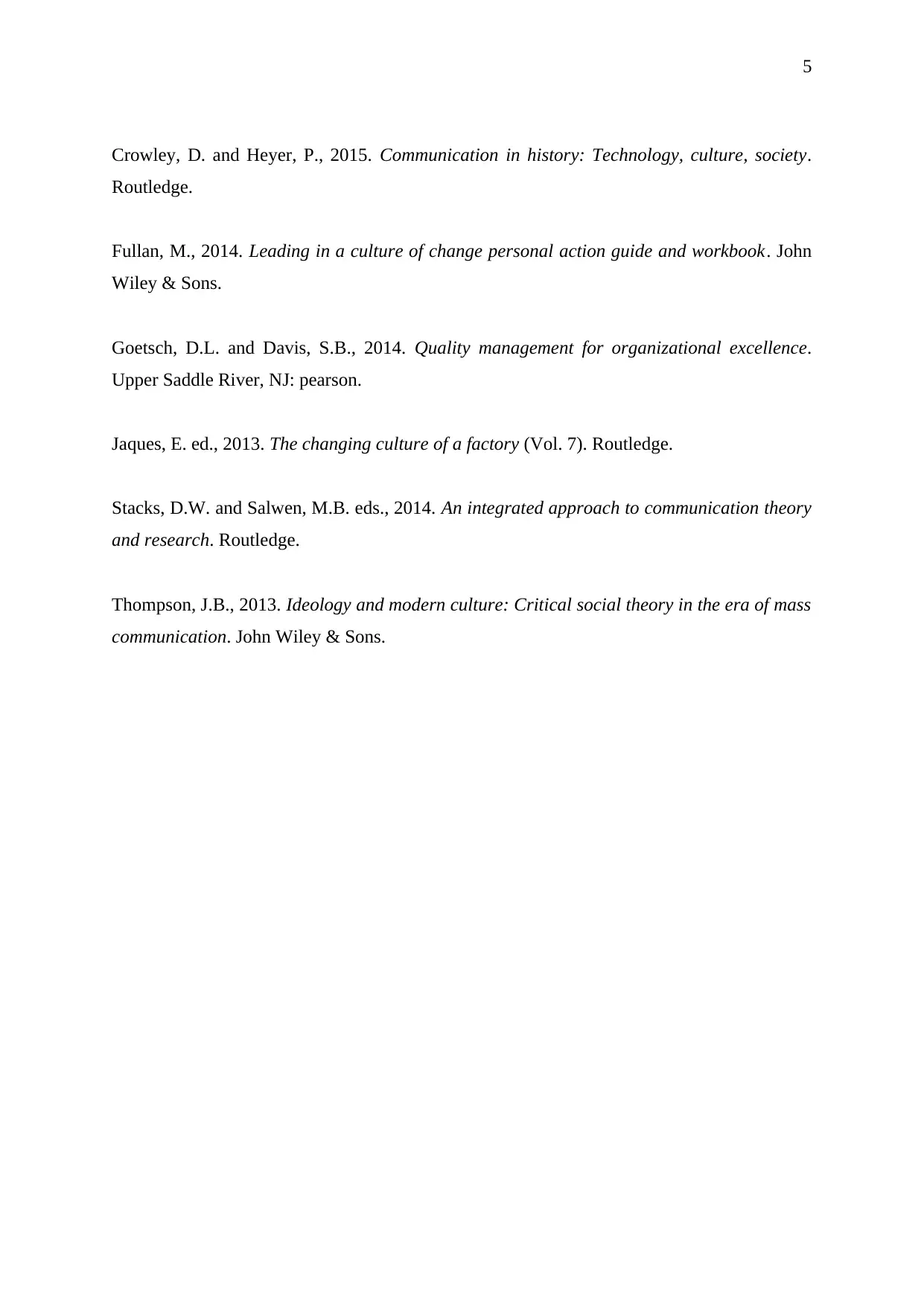
5
Crowley, D. and Heyer, P., 2015. Communication in history: Technology, culture, society.
Routledge.
Fullan, M., 2014. Leading in a culture of change personal action guide and workbook. John
Wiley & Sons.
Goetsch, D.L. and Davis, S.B., 2014. Quality management for organizational excellence.
Upper Saddle River, NJ: pearson.
Jaques, E. ed., 2013. The changing culture of a factory (Vol. 7). Routledge.
Stacks, D.W. and Salwen, M.B. eds., 2014. An integrated approach to communication theory
and research. Routledge.
Thompson, J.B., 2013. Ideology and modern culture: Critical social theory in the era of mass
communication. John Wiley & Sons.
Crowley, D. and Heyer, P., 2015. Communication in history: Technology, culture, society.
Routledge.
Fullan, M., 2014. Leading in a culture of change personal action guide and workbook. John
Wiley & Sons.
Goetsch, D.L. and Davis, S.B., 2014. Quality management for organizational excellence.
Upper Saddle River, NJ: pearson.
Jaques, E. ed., 2013. The changing culture of a factory (Vol. 7). Routledge.
Stacks, D.W. and Salwen, M.B. eds., 2014. An integrated approach to communication theory
and research. Routledge.
Thompson, J.B., 2013. Ideology and modern culture: Critical social theory in the era of mass
communication. John Wiley & Sons.
1 out of 5
Related Documents
Your All-in-One AI-Powered Toolkit for Academic Success.
+13062052269
info@desklib.com
Available 24*7 on WhatsApp / Email
![[object Object]](/_next/static/media/star-bottom.7253800d.svg)
Unlock your academic potential
Copyright © 2020–2025 A2Z Services. All Rights Reserved. Developed and managed by ZUCOL.





